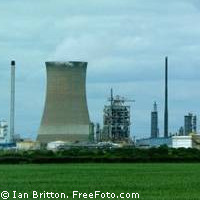Satellite provides first pictures of regional CO2 emissions
The SCIAMACHY sensor aboard the European Space Agency's Envisat environmental satellite has detected for the first time the regional distribution of carbon dioxide from manmade emissions. An elevated level of this form of CO2 was observed over Europe's most populated area, the region between Amsterdam in the Netherlands and Frankfurt in Germany. CO2 emissions are produced naturally by all animals, plants, fungi and microorganisms during respiration. An extra 30 billion tonnes of CO2 is released into the atmosphere annually by human activities, mainly through the burning of fossil fuels for power generation, industry and traffic. According to the Intergovernmental Panel on Climate Change (IPCC), as CO2 emissions and other greenhouse gas levels have risen, so have air and ocean temperatures increased, resulting in rising sea levels, melting ice caps and more extreme weather conditions. To better predict future emissions, however, further understanding of both natural and manmade CO2 fluxes are needed. This is where SCIAMACHY comes in. The instrument maps the air over a very wide wavelength range, which allows detection of trace gases, ozone and related gases, clouds and dust particles throughout the atmosphere. It works by measuring sunlight, transmitted, reflected and scattered by the earth's atmosphere or surface in the ultraviolet, visible and near infrared wavelength region. With a 960km swath it covers the entire world every six days. By processing and analysing data from the instrument, Michael Buchwitz from the Institute of Environmental Physics (IUP) at the University of Bremen in Germany and his colleagues were able to detect the relatively weak atmospheric CO2 signal arising from regional 'anthropogenic', or manmade, CO2 emissions over Europe. It showed an extended plume of CO2 hanging over Amsterdam all the way to Frankfurt. Detecting this manmade CO2 flux is no easy feat, as Dr Buchwitz explains: 'The natural CO2 fluxes between the atmosphere and the Earth's surface are typically much larger than the CO2 fluxes arising from manmade CO2 emissions, making the detection of regional anthropogenic CO2 emission signals quite difficult. That we are able to detect regionally elevated CO2 over Europe shows the high quality of the SCIAMACHY CO2 measurements.' The team of researchers will now further analyse their observations. 'We verified that the CO2 spatial pattern that we measure correlates well with current CO2 emission databases and population density but more studies are needed before definitive quantitative conclusions concerning CO2 emissions can be drawn,' says Dr Buchwitz. Much work still remains to understand CO2 sources, such as fires, volcanic activity and the respiration of living organisms, and its natural sinks, such as the land and ocean. 'We know that about half of the CO2 emitted by mankind each year is taken up by natural sinks on land and in the oceans. We do not know, however, where exactly these important sinks are and to what extent they take up the CO2 we are emitting,' explains Dr Buchwitz. It is expected that the data obtained from the SCIAMACHY will help not only shed light on CO2 sources and sinks, but also on how carbon sinks will respond to a changing climate. 'With our satellite measurements we hope to be able to provide answers to questions like this in order to make reliable predictions,' says Dr Buchwitz. With these predictions, scientists will be better equipped to monitor progress towards reducing greenhouse gas emissions, as required by the Kyoto Protocol. The SCIAMACHY instrument is funded by the German government through the German Aerospace Centre (DLR), the Dutch government through the Netherlands Agency for Aerospace Programmes (NIVR) and also the Belgian government through BIRA-IASB.



